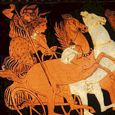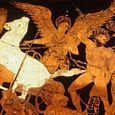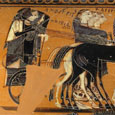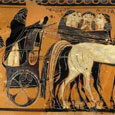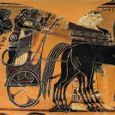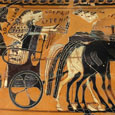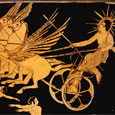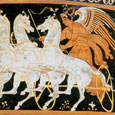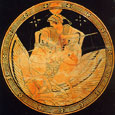HIPPOI ATHANATOI
Greek Name
Ἱππος
Αθανατος
Ἱπποι Αθανατοι
Transliteration
Hippos Athanatos
Hippoi Athanatoi
Latin Spelling
--
Translation
Immortal Horses
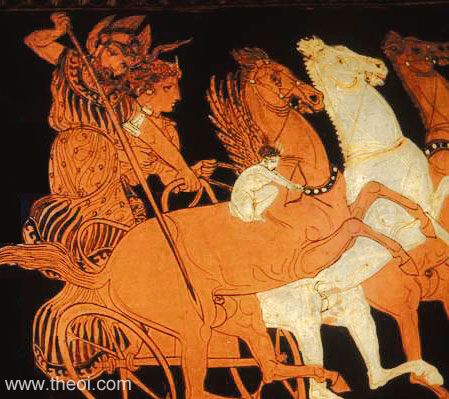
THE HIPPOI ATHANATOI were the immortal horses of the gods. Most of these divine steeds were offspring of the four Anemoi (Wind-Gods) who themselves drew the chariot of Zeus in the guise of horses.
FAMILY OF THE HORSES
PARENTS
Mostly offspring of the ANEMOI, the HARPYIAI and POSEIDON (Various sources)
LIST OF IMMORTAL HORSES
ABRAXAS An alternative name for one of the four immortal horses of the sun-god Helios.
AITHON (1) (Aethon) One of the fire-breathing steeds of Ares.
AITHON (2) (Aethon) An alternative name for one of the four immortal horses of the sun-god Helios.
AITHOPS (Aethops) One of the four immortal horses of the sun-god Helios.
ANEMOI, THE The gods of the four winds, who in the guise of horses drew the chariot of Zeus.
AREION (Arion) An immortal horse owned by Herakles and later the hero Adrastos.
BALIOS (Balius) One of a pair of immortal horses gifted to the hero Peleus by the gods. The drove the chariot of his son Akhilleus (Achilles) in the Trojan War.
BOREAS The god of the North-Wind who, in the shape of a horse, drew the chariot of Zeus.
BRONTE One of the four immortal horses of the sun-god Helios.
EUOS One of the four immortal horses of the sun-god Helios.
EUROS (Eurus) The god of the East-Wind who, in the shape of a horse, drew the chariot of Zeus.
HARPAGOS (Harpagus) One of the immortal horses of the Dioskouroi (Dioscuri) twins.
HIPPALEKTRYON (Hippalectryon) A creature with the foreparts of a rooster and the rearparts of a horse.
HIPPOKAMPOI (Hippocamps) Fish-tailed horses of the sea, four of which drew the chariot of Poseidon.
KONABOS (Conabus) One of the fire breathing steeds of Ares.
KYLLAROS (Cyllarus) One of the immortal horses of the Dioskouroi (Dioscuri) twins.
LAMPOS (Lampus) One of the two immortal steeds of the dawn-goddess Eos.
NOTOS (Notus) The god of the South-Wind who, in the shape of a horse, drew the chariot of Zeus.
PEGASOS (Pegasus) A winged immortal horse born from the neck of the beheaded Gorgon Medousa (Medusa).
PEGASOI (Pegasi) A breed of winged immortal horses.
PHAETHON One of the two immortal steeds of the dawn-goddess Eos.
PHLEGON An alternative name for one of the four immortal horses of the sun-god Helios.
PHLOGEUS (1) One of the immortal horses of the Dioskouroi (Dioscuri) twins.
PHLOGEUS (2) One of the fire-breathing steeds of Ares.
PHOBOS (Phobus) One of the fire-breathing steeds of Ares.
PODARKES (Podarces) One of a pair of immortal horses owned by Erekhtheus (Erechtheus), king of Athens.
PYROIS An alternative name for one of the four immortal horses of the sun-god Helios.
SKYLLA (Scylla) One of the eight immortal horses which drew the chariot of Poseidon.
STEROPE One of the four immortal horses of the sun-god Helios.
STHENIOS (Sthenius) One of the eight horses of the sea-god Poseidon.
THERBEEO An alternative name for one of the four immortal horses of the sun-god Helios.
TROJAN HIPPOI, THE The twelve immortal horses owned by the Trojan kings Erikhthonios (Erichthonius) and Laomedon. They were promised to Herakles as reward for rescuing princess Hesione from a sea-monster.
XANTHOS (1) (Xanthus) One of a pair of immortal horses gifted to the hero Peleus by the gods. The drove the chariot of his son Akhilleus (Achilles) in the Trojan War.
XANTHOS (2) (Xanthus) One of the immortal horses of the Dioskouroi (Dioscuri) twins.
XANTHOS (3) (Xanthus) One of a pair of immortal horses owned by Erekhtheus (Erechtheus), king of Athens.
ZEPHYROS (Zephyrus) The god of the West-Wind who, in the shape of a horse, drew the chariot of Zeus.
ALTERNATE NAMES
Greek Name
Ἱππος
Αμβροτος
Ἱπποι Αμβροτοι
Transliteration
Hippos Ambrotus
Hippoi Ambrotoi
Latin Spelling
--
--
Translation
Divine Horse
Divine Horses
CLASSICAL LITERATURE QUOTES
THE HORSES OF HERA
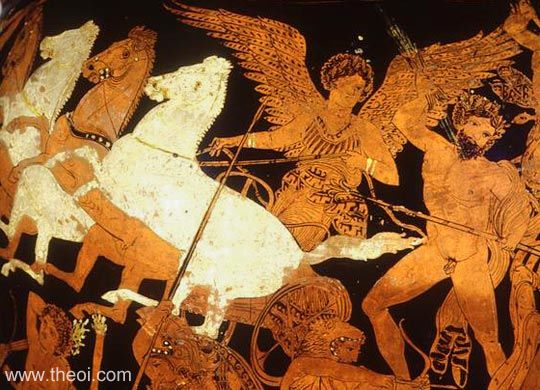
Homer, Iliad 5. 711 ff (trans. Lattimore) (Greek epic C8th B.C.) :
"Hera, high goddess, daughter of Kronos (Cronus) the mighty, went away to harness the gold-bridled
[immortal] horses. Then Hebe in speed set about the chariot the curved wheels eight-spoked and brazen, with an
axle of iron both ways. Golden is the wheel's felly imperishable, and outside it is joined, a wonder to look
upon, the brazen running-rim, and the silver naves revolve on either side of the chariot, whereas the car itself
is lashed fast with plaiting of gold and silver, with double chariot rials that circle about it, and the pole of
the chariot is of silver, to whose extremity Hebe made fast the golden and splendid yoke, and fastened the
harness, golden and splendid, and underneath the yoke Hera, furious for hate and battle, led the swift-running
horses . . .
Hera laid the lash swiftly on the horses; and moving of themselves groaned the gates of the sky that the Horai
(Horae) guarded . . . Through the way between they held the speed of their goaded horses . . .
Hera lashed on the horses, and they winged their way unreluctant through the space between the earth and the
starry heaven. As far as into the hazing distance a man can see with his eyes, who sits in his eyrie gazing on
the wine-blue water, as far as this is the stride of the gods' proud neighing horses. Now as they cam to Troy
land and the two running rivers where Simoeis and Skamandros (Scamander) dash their waters together, there the
goddess of the white arms, Hera, stayed her horses, slipping them from the chariot, and drifting close mist
about them, and Simoeis grew as grass ambrosia for them to graze on."
Valerius Flaccus, Argonautica 5. 184 ff (trans. Mozley) (Roman epic C1st A.D.)
:
"Juno [Hera] and Pallas [Athena] in full panoply of glittering cloud, bring to a halt the chariots of the
wing-footed steeds."
THE HORSES OF ZEUS
Quintus Smyrnaeus, Fall of Troy 12. 189 ff (trans. Way) (Greek epic C4th A.D.)
:
"Zeus, at the utmost verge of earth, was ware of all: straight left he Okeanos' (Oceanus') stream, and to
wide heaven ascended, charioted upon the Anemoi (Winds), Euros (the East), Boreas (the North), Zephyros (the
West-wind), and Notos (the South) : for Iris rainbow-plumed led 'neath the yoke of his eternal ear that stormy
team, the ear which Aion (Time) the immortal framed for him of adamant with never-wearying hands." [N.B.
The four-wind gods are assumed to have the guise of horses.]
THE HORSES OF POSEIDON
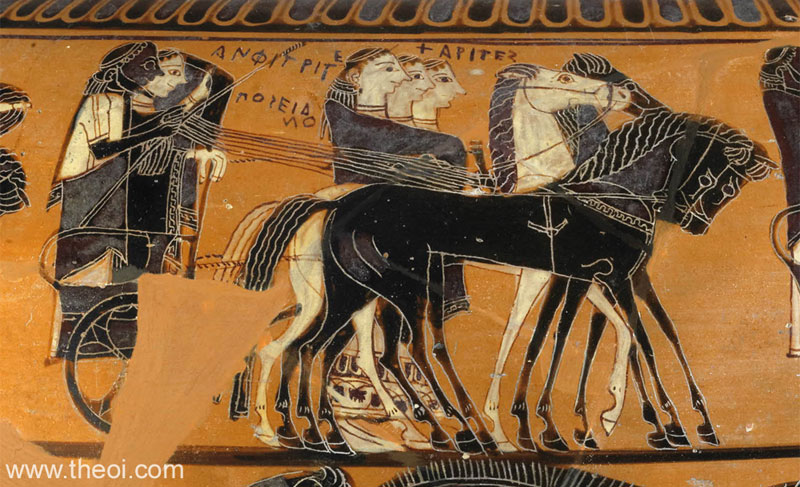
Quintus Smyrnaeus, Fall of Troy 5. 88 ff (trans. Way) (Greek epic C4th A.D.)
:
"[Depicted on the shield of Akhilleus (Achilles) :] And there triumphant the Earth-shaker [Poseidon] rode
amid Ketea (Cetea, Sea-Monsters): stormy-footed steeds [i.e. Hippokampoi (Hippocamps)] drew him, and seemed
alive, as o'er the deep they raced, oft smitten by the golden whip. Around their path of flight the waves fell
smooth, and all before them was unrippled calm. Dolphins on either hand about their king swarmed, in wild
rapture of homage bowing backs, and seemed like live things o'er the hazy sea swimming, albeit all of silver
wrought."
Nonnus, Dionysiaca 1. 207 ff (trans. Rouse) (Greek epic C5th A.D.) :
"Many a time in the weedy gulf he [Typhoeus] seized Poseidon's chariot, and dragged it from the depths of
the sea to land; again he pulled out a stallion by his brine-soaked mane from the undersea manger, and threw the
vagabond nag to the vault of heaven, shooting his shot at Olympos--hit Helios the Sun's chariot, and the horses
on their round whinnied under the yoke."
THE HORSES OF ARES
See the HIPPOI AREIOI
IMMORTAL HORSES MISCELLANY
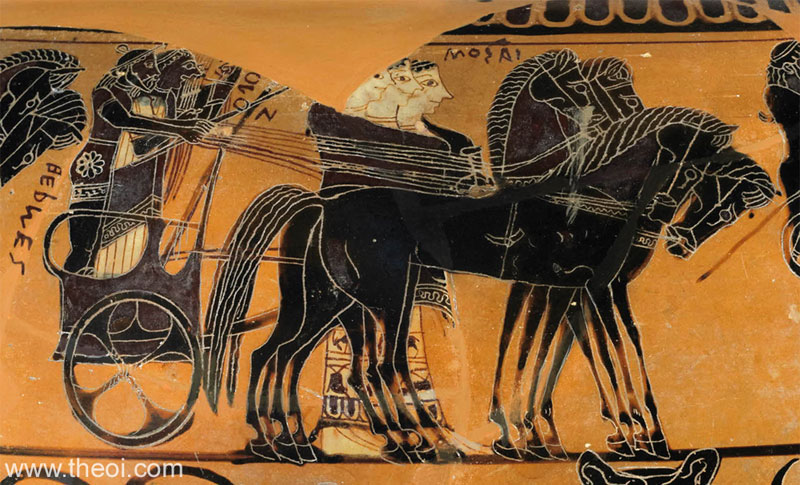
Plato, Phaedrus 246 (trans. Fowler) (Greek philosopher C4th B.C.) :
"A pair of winged horses and a charioteer. Now the winged horses and the charioteers of the gods are all of
them noble and of noble descent . . . Zeus, the mighty lord, holding the reins of a winged chariot, leads the
way in heaven, ordering all and taking care of all; and there follows him the array of gods and demigods,
marshalled in eleven bands [i.e. of the twelve Olympians] . . . The chariots of the gods in even poise, obeying
the rein, glide rapidly . . . she passes down into the interior of the heavens and returns home; and there the
charioteer putting up his horses at the stall, gives them ambrosia to eat and nectar to drink."
Oppian, Cynegetica 1. 225 (trans. Mair) (Greek poet C3rd A.D.) :
"To Horses beyond all mortal creatures cunning Nature has given a subtle mind and heart. Always they know
their own dear charioteer and they neigh when they see their glorious rider and greatly mourn their comrade when
he falls in war. Ere now in battle a horse [Xanthos] has burst the bonds of silence and overleapt the ordinance
of nature and taken a human voice and a tongue like that of man . . . A horse [Areion (Arion)] there was which
ran with light feet over the corn-ears and brake them not; another [offspring of Boreas] ran over the sea and
wetted not his coronet. A horse [Pegasos] carried above the clouds him [Bellerophon] that slew the Khimaira
(Chimera)."
OTHER CHARIOT-BEASTS OF THE GODS
Some of the gods employed had more fabulous creatures draw their chariots:--
Aphrodite's chariot was drawn by doves or a pair of winged Erotes (Love-Gods);
Apollon's chariot was sometimes drawn by swans;
Artemis' chariot was drawn by the four Kerynitian Hinds, immortal
golden-horned deer;
Demeter's chariot was borne through the air by winged Drakones (Dragon-Serpents);
Dionysos' chariot was harnessed with four panthers;
Nemesis' chariot was pulled by four Grypes (Griffins);
Poseidon's sea-chariot was sometimes drawn by Hippokampoi (Hippocamps);
Selene's chariot was drawn by oxen or Pegasoi (Pegasi);
Rhea's chariot was pulled by lions.
ANCIENT GREEK ART
SOURCES
GREEK
- Homer, The Iliad - Greek Epic C8th B.C.
- Plato, Phaedrus - Greek Philosophy C4th B.C.
- Oppian, Cynegetica - Greek Poetry C3rd A.D.
- Quintus Smyrnaeus, Fall of Troy - Greek Epic C4th A.D.
BIBLIOGRAPHY
A complete bibliography of the translations quoted on this page.
